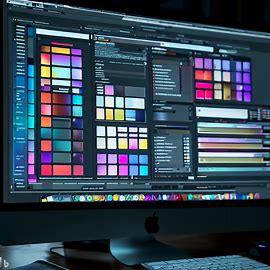Palettes in PageMaker: A Comprehensive Guide
Table of Contents
- Introduction
- Understanding PageMaker Palettes
- Types of Palettes in PageMaker
- Toolbox Palette
- Control Palette
- Color Palette
- Swatches Palette
- Layers Palette
- Links Palette
- Pages Palette
- The Role and Functionality of Each Palette
- How Palettes Enhance Your Design Workflow
- Conclusion
Introduction
In the world of digital design, PageMaker stands as a reliable companion for crafting captivating documents. One of its standout features is the incorporation of palettes, which play a pivotal role in enhancing the design process. This article aims to provide a simplified explanation of what palettes are in PageMaker and delves into the various types of palettes available, shedding light on their functionalities and how they contribute to an efficient design workflow.
Understanding PageMaker Palettes
Palettes in PageMaker are interactive panels that house essential tools, controls, and options needed for various design tasks. These palettes streamline the design process by offering quick access to specific functions without the need to navigate through complex menus.
Types of Palettes in PageMaker
Let’s explore the key palettes that form the core of PageMaker’s interface:
Toolbox Palette
The Toolbox Palette is a versatile collection of tools that empower users to create, manipulate, and design elements. It includes tools for creating shapes, adding text, inserting images, and more. With a simple click on a tool’s icon, you activate its function, allowing for seamless design execution.
Control Palette
The Control Palette complements the Toolbox by offering detailed options and settings for selected elements. It dynamically adapts based on the selected tool or object, providing an array of options such as font size, alignment, color adjustments, and object dimensions. This palette eliminates the need to hunt through menus, ensuring a focused and efficient design process.
Color Palette
The Color Palette facilitates the selection and application of colors to various design elements. It offers a spectrum of colors that can be customized to match your project’s aesthetic. By clicking on a color, you can instantly apply it to text, shapes, and other design components.
Swatches Palette
The Swatches Palette stores a collection of predefined color sets, making it easy to maintain a consistent color scheme throughout your design. It’s particularly useful when you want to ensure that the same colors are used consistently across different elements.
Layers Palette
The Layers Palette provides a structured approach to managing complex designs. It allows you to organize elements into separate layers, enabling you to work on individual components without affecting others. This helps maintain design integrity and simplifies edits and adjustments.
Links Palette
The Links Palette keeps track of external assets, such as images or graphics, that are imported into your document. It displays the status of linked files and allows you to update or replace them as needed. This ensures that your design remains intact, even if linked assets change.
Pages Palette
The Pages Palette offers an overview of your document’s structure. It displays thumbnails of each page, allowing you to navigate and rearrange pages effortlessly. This is particularly useful when working on multi-page projects like brochures or magazines.
The Role and Functionality of Each Palette
- Toolbox Palette: Enables creation and manipulation of design elements.
- Control Palette: Provides in-depth options for selected elements, reducing the need for menu navigation.
- Color Palette: Facilitates color selection and application, enhancing visual appeal.
- Swatches Palette: Ensures color consistency and simplifies color application.
- Layers Palette: Organizes elements into layers for efficient management and editing.
- Links Palette: Manages external assets, maintaining design integrity.
- Pages Palette: Offers an overview and navigation of multi-page documents.
How Palettes Enhance Your Design Workflow
- Efficiency: Palettes reduce the need to navigate menus, allowing you to access tools and options with fewer clicks.
- Visual Consistency: The Color Palette and Swatches Palette ensure a harmonious color scheme.
- Organization: The Layers Palette and Pages Palette help manage complex projects, ensuring order and accessibility.
Conclusion
PageMaker’s palettes are the unsung heroes of the design process. From the versatile Toolbox Palette to the powerful Control Palette, each component serves a distinct purpose, contributing to an intuitive and streamlined design experience. By understanding the functions of these palettes, designers can harness the full potential of PageMaker, creating captivating layouts with efficiency and ease. Embrace the power of palettes and elevate your design game to new heights.
In simple term : palettes in DTP/Pagemaker are following:
In Adobe PageMaker, palettes are interactive panels or windows that provide quick access to various tools, settings, and features. These palettes play a crucial role in streamlining your design workflow by allowing you to manage different aspects of your project more efficiently. Each palette serves a specific purpose and helps you accomplish tasks ranging from design and layout to text formatting and color selection. Let’s explore the different palettes in Adobe PageMaker:
1. Toolbox Palette: The Toolbox Palette is a collection of icons representing various tools used for tasks such as selecting, drawing shapes, adding text, working with images, and more. Each icon corresponds to a specific tool, allowing you to easily switch between different actions while working on your publication.
2. Control Palette: The Control Palette is context-sensitive and displays options and settings related to the currently selected tool or object. For example, if you’re working with a text box, the Control Palette will provide options to change font size, alignment, color, and other text-related properties.
3. Color Palette: The Color Palette provides a spectrum of colors that you can choose from when applying color to text, shapes, backgrounds, and other elements in your design. You can select colors from the palette or define custom colors to match your design’s requirements.
4. Swatches Palette: The Swatches Palette contains a collection of saved color swatches. Swatches are predefined colors that you can reuse throughout your design to maintain consistency. This palette allows you to easily access and apply your chosen color scheme.
5. Layers Palette: The Layers Palette enables you to organize and manage different elements of your design on separate layers. Layers help you control the visibility and arrangement of objects, making it easier to work with complex designs by isolating specific elements.
6. Links Palette: The Links Palette displays a list of linked files, such as images or graphics, used in your publication. It provides information about the linked files’ status, location, and resolution. You can update, relink, or manage your linked files directly from this palette.
7. Pages Palette: The Pages Palette provides a visual representation of the pages in your publication. It displays thumbnail images of each page, allowing you to navigate through your document, rearrange pages, and manage master pages for consistent layouts.
Each of these palettes contributes to a more intuitive and efficient design process in Adobe PageMaker. By utilizing these palettes effectively, you can enhance your productivity, ensure consistency in design elements, and create professional-looking publications with ease.


